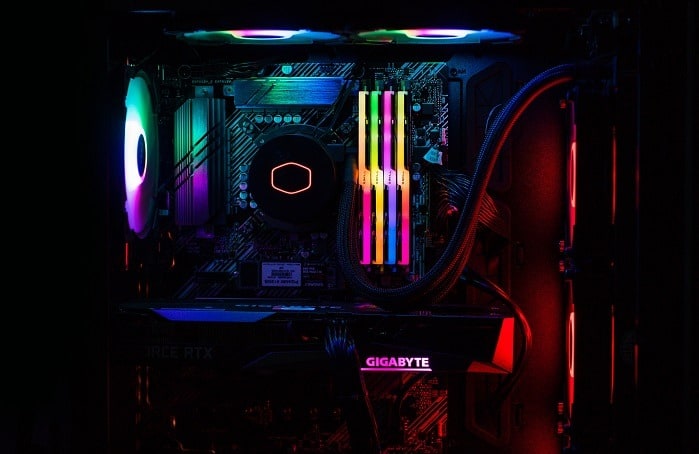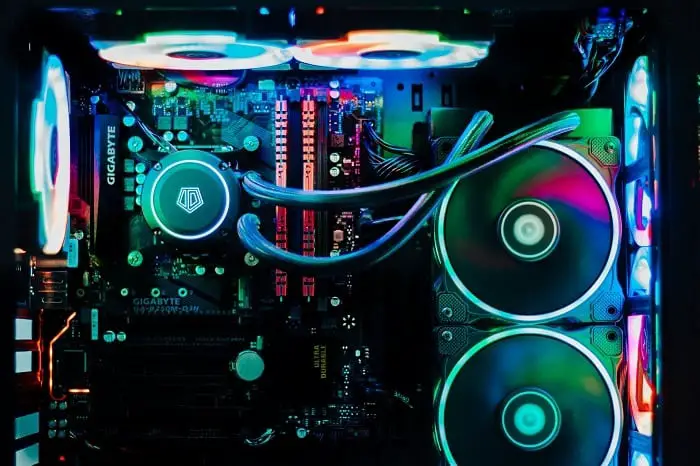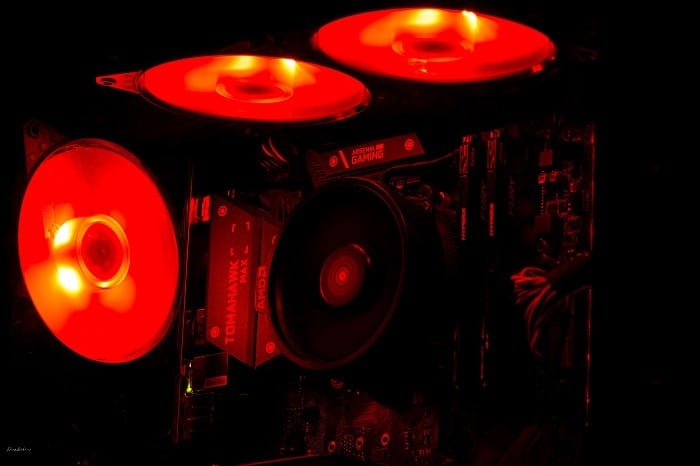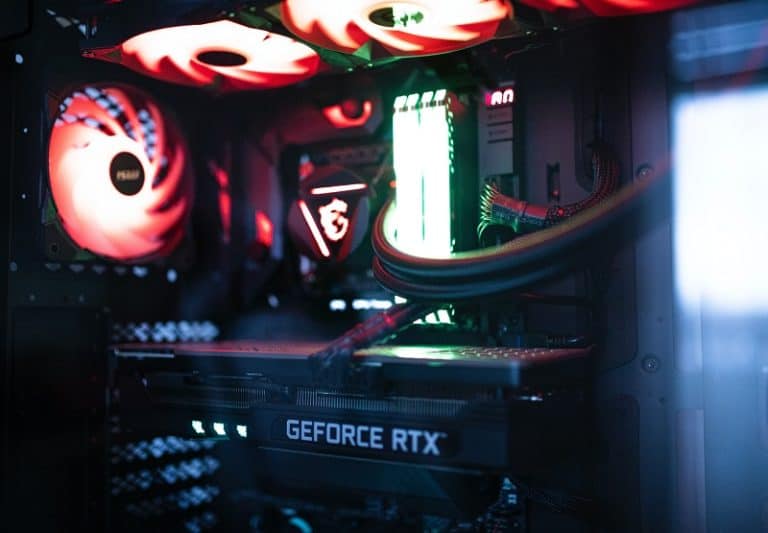Do you feel your computer is losing its performance and efficiency due to regular overheating from hours of gaming? Then, it is not hard to guess that you must be looking for a good way to monitor the temperature of your CPU and GPU while gaming. Don’t worry, we’ve got you covered!
So how do you monitor CPU and GPU temp while gaming? You can monitor CPU and GPU Temp while gaming using a few trusted and free tools like ‘MSI Afterburner’, ‘NZXT Cam’, HWMonitor, ‘Real Temp’, ‘CoreTemp’, ‘Smart Game Booster’ etc. Online gaming sites like Steam, Origin, and Valve also let you monitor CPU and GPU temp.
In this article, we will talk in detail about how to monitor CPU and GPU temp while gaming in some best ways along with providing a list of the best tools and software that can simply and efficiently do the job for you.
Standard CPU and GPU Temp
Just monitoring the temperature of your CPU and GPU won’t help you if you don’t know what actually is the standard and ideal temperature of the CPU and GPU. The preferred temperature limits of the CPU and the GPU are different. Because even though they work together, they are two different things with two different functions.
The standard temp of the CPU (Central Processing Unit) is 75 to 80 degrees of Celsius (167 to 176 degrees of Fahrenheit). On the other hand, the standard temp of GPU (Graphics Processing Unit) is 65 to 85 degrees of Celsius (149 to 185 degrees of Fahrenheit).
If the temperature rises a few degrees above these limits, it’s still not a big deal. However, if the temperature rises more than 90 degrees of Celsius (190 degrees of Fahrenheit), it will be a matter of concern, since a temperature that high can severely damage your CPU and GPU and cause information loss.

Ranges of CPU and GPU Temp for Different Loads
Since the CPU and GPU are two of the most important parts of a computer in the case of both heavy users and light users. They are the key factors behind maintaining the efficiency of the computer and are responsible for pulling out a number of significant functions of the computer.
And that is the reason why the standard temp of CPU and GPU are variable from one computer to another, one user to another, and one work type to another. The ideal temperature from different CPU loads is different.
To help you figure out the ideal CPU temp for your usage, here is a chart comparing CPU temp ranges for different CPU loads.
| CPU Load | Ideal Temp(Celsius) | Average Temp(Celsius) | Unpreferred Temp(Celsius) | Risky Temp(Celsius) |
| <50% Load | <35 degrees | 35-45 degrees | 45-50 degrees | >50 degrees |
| 50% Load | <50 degrees | 50-65 degrees | 65-75 degrees | >75 degrees |
| 100% Load | <60 degrees | 60-80 degrees | 80-85 degrees | >85 degrees |
And the chart below shows the same data for GPU.
| GPU Load | Ideal Temp(Celsius) | Average Temp(Celsius) | Unpreferred Temp(Celsius) | Risky Temp(Celsius) |
| <50% load | <40 degrees | 40-50 degrees | 50-60 degrees | >60 degrees |
| 50% load | <55-60 degrees | 60-65 degrees | 65-70 degrees | >70 degrees |
| 100% load | <65 degrees | 65-80 degrees | 80-95 degrees | >95 degrees |
Why do You need to Monitor CPU and GPU Temp While Gaming?
Monitoring CPU and GPU temp is not only important while gaming but also during regular use. However, since the CPU and GPU tend to overheat more while gaming non-stop for hours damaging the system gradually, it is more essential to keep checking the temp, especially while gaming.
Gaming itself is a huge load on a CPU of a computer or laptop. This is one of the reasons why there are several CPUs/GPUs and laptops that are designed particularly for gaming.
However, if you put too much load that your CPU can’t bear and over-clock regularly, it will cause both your CPU and GPU to heat up quickly which will not be above the ability of the system cooling fan to handle.
Thus, to keep a record of whether you are over-clocking or not and if most importantly, it is affecting your computer or not by overheating it, you need to monitor your CPU and GPU temp while gaming.
4 Major Ways to Monitor CPU and GPU Temp While Gaming
Now, let’s talk business. Below we are listing out some of the best ways to monitor your CPU and GPU temp while. Take a look!
CPU and GPU Utility
If you have an AMD processor, monitoring the temp of both your CPU and GPU is an easy job for you. Because AMD has its own processor tuning utility to monitor the temperature of the CPU and control system for monitoring the temperature of GPU while gaming. The tuning utility of AMD is called the Ryzen Master. Along with the temp, you can also monitor the overclocking or underclocking using these utilities.
However, if you do not have an AMD processor, you can monitor the temp of your CPU with the Extreme Tuning Utility of the Intel processor. And also, if you’re into NVIDIA, they have control panels of their own to monitor the temp of the GPU without pausing the game.
Temperature Sensor
A temperature sensor, also called a heat probe, is an external sensor that you will need to install with your computer case. Even though it seems like a hassle and requires expenditure, once you install one, you’ll realize it’s worth it because you don’t have to do any additional things to check the temperature, the device will always display it on an LED screen while the computer is on.
In-Game FPS Counters
This is an option limited to games available only on some particular websites with FPS counters. So, if the game you are into, is not available on that very site, then this option might not be able to help you. Gaming websites like Steam and Origin have in-game FPS counters. So, if these websites offer the game you play, you don’t have to take any extra hassle. Just enable the in-game FPS counter. That’s it!
BIOS
BIOS (Basic Input Output System) is one of the simplest ways of monitoring the CPU and GPU temp without having to install any additional applications. It is a program that is stored in a small memory chip inside the motherboard.
BIOS is generally required to instruct the computer for doing basic functions and to check and configure the hardware status of the computer, such as the CPU, memory, hard drive, floppy drive, and so on.
The interface of BIOS differs from one motherboard to another. However, all BIOS have the option, “Hardware Monitor” from which the CPU temperature can be monitored. Here’s what you need to do to access the BIOS setting in order to monitor the CPU and GPU temperature of your computer.
- Turn on, restart, or re-boot your computer.
- During the bootup process, you need to press the BIOS key. The BIOS key is different for different computers. But usually, it is Delete, Esc, F1, F2, or F10. The correct BIOS key for your computer will be displayed on the same screen as the manufacturers’ logos.
- You are required to press the key on time during the bootup process. If you don’t, your computer will start normally and to access BIOS you’ll have to restart the computer again.
- After you access the BIOS, you will be shown the option of choosing from different tabs, select “CPU Settings” from there.
- You will get the CPU temperature in the CPU settings.
While accessing the BIOS, don’t freak out if you click on some wrong key. Because before you exit BIOS, you will be asked if you want to save the changes. One of the downfalls of BIOS is that every time you need to monitor your CPU temp, you will have to restart your computer. So, it is not a favorable option for monitoring the CPU temp while you’re in the game.
Other Tools to Monitor CPU and GPU Temp While Gaming
Till now, we have only talked about different ways to monitor CPU and GPU temp while gaming without the requirement of downloading any additional tool or software. However, there are different other software that you can download to monitor both temperatures of the CPU and GPU efficiently. Here is a list of the few most prominent ones.
1. MSI Afterburner
MSI Afterburner is one of the most popular tools to monitor CPU and GPU temp. Alongside monitoring the CPU and GPU temp while gaming, it provides several other monitoring and control features.
One of the best features of MSI Afterburner that makes it so well-accepted is that it not only provides the option for monitoring the temp but also lets you control the temperature according to the requirement.
Such as, if you find your CPU or GPU overheating while you’re gaming, you will have the option to control the cooling fan of your computer and increase or regulate it as per the temperature. This tool is exclusively designed for gamers and other heavy users. It is much popular among pro gamers to monitor CPU and GPU temp.
2. NZXT Cam
If you’re looking for a top-notch free tool to monitor the temp of your CPU and GPU, this is the one. NZXT Cam is a free application that NZXT has launched to promote its products. And so, if you install this application, you will have to tolerate several advertisements of NZXT products.
However, this is nothing if you compare it with the service they provide without any charge. Because NZXT Cam does not only let you monitor the temperature of your CPU and GPU while you’re gaming, they additionally notify you with automated texts when the temperature rises above the standard level.
Another amazing feature NZXT Cam offers is that it has a mobile version through which you get the option to monitor the temperature and several other info about your CPU and GPU remotely.
3. Open Hardware Monitor
When your priority list tops a simpler user interface, Open Hardware Monitor is what you are looking for. It is an open-source application that has one of the simplest and most well-detailed user interfaces.
The Open Hardware Monitor, along with the temperature of the CPU and GPU, will also show information about the fan speed, clock speed, load, and voltages. Open Hardware Monitor is also one of the best in terms of the accuracy of the details.
Because it reads the core temperature sensor of AMD and Intel processors. Apart from that, the Open Hardware Monitor often undergoes updates to prevent bugs and add new features.
4. HWMonitor
HWMonitor is another application that provides information on the CPU and GPU of the computer almost similar to the Open Hardware Monitor. It also takes the data from the temperature sensor of the motherboard.
And it displays all the data of the CPU and GPU that Open Hardware Monitor provides, such as fan speed, clock speed, voltage, power supply, and so on. However, this application is quite space-saving. It does not require much space for this tool and it is easy and handy to access while gaming.
5. HWiNFO
HWiNFO is a complex and professional tool for extra detailed and analyzed reports on the function of the CPU, GPU, and other system software of the computer. It not only helps you monitor the condition or status of your computer system but also predicts risks of future failures.
This is one of the best tools for professionals. However, to use this tool, it is required to understand and study it first. Because it has comparatively quite a difficult user interface with a complex arrangement of a huge amount of data.
6. Speccy
Speccy is a tool that helps one to optimize their device. It analyzes almost every aspect of the computer and presents it in a simpler user interface. Alongside the CPU and GPU temp, Speccy also analyzes the condition of the motherboard.
Moreover, Speccy provides the option of taking a snapshot of the hardware reading or saving it as an XML file or text file to keep a record. Speccy is available in three different versions. They are Free, Professional, and Professional Plus.
Among these three versions, the Free version offers a service that includes monitoring different aspects of the hardware free of cost. The other two charges money for the service.
Between them, the Professional version offers the same services as the free version, but with frequent updates. However, the professional plus version, which is the most expensive one provides much more detailed information about the system software.
7. Real Temp
Real Temp is yet another hardware monitoring tool. However, it is designed exclusively for Intel processors. This is a plug and plays free software, so no need to install it. And you get all the necessary information about your CPU and GPU absolutely free of cost.
As the name describes, the tool ensures and displays the real and accurate temperature of the CPU and GPU by reading it from the Digital Thermal Sensor of the system.
8. CoreTemp
If your only requirement is to monitor the CPU and GPU temp while gaming in the most efficient way, free of cost, and with less space requirement, CoreTemp brings you the best of both worlds. It has a pretty simple user interface that is both easily accessible and monitored as well as understandable.
CoreTemp is absolutely free of cost and it occupies a very small amount of space. Moreover, like Real Temp, CoreTemp also collects the CPU and GPU temperature reading from the Digital Thermal Sensor of the system.
Therefore, there’s no doubt about accuracy. And guess what, it works on almost all types of processors. However, you need to install the application that isn’t required in the case of Real Temp.

Benefits of Monitoring CPU and GPU Temperature
Monitoring your CPU and GPU temp is highly advantageous. If you regularly monitor the temperature of your CPU and GPU while working or gaming on your computer, maintain a standard temperature, and prevent over-heating, it will benefit you more than you think. Here are a few benefits that are related to monitoring CPU and GPU temp while computing.
Helps Increase Computer Performance
The performance and speed of your computer hamper highly because of increased CPU temp. Gradually, your computer will tend to get much slower and less efficient which will cause a loss of your valuable time and will hamper your regular tasks and gaming in every way possible. Hence, to ensure your computer runs at a standard speed, monitoring the CPU temp is very helpful.
Prevents the Computer from Heat Damage
As said before, the CPU is one of the most important parts of a computer. When the CPU starts damaging, the entire computer gets affected by it. Excessive heat produced by the CPU and GPU can damage the entire system of your computer massively. And this might further lead to several disrupting malfunctions and abnormal shutdowns.
Increases the Lifespan of the Computer
Yes, the heat produced by your CPU or GPU also influences the lifespan of your computer. If you manage to maintain an optimal temperature and prevent over-heating and over-clocking, your computer will serve you much longer than it would if it regularly gets over-heated.
Ensure Uptime and Reliability of the Data Center
To ensure optimal uptime and reliability of the data center, along with the temp of the CPU and GPU, several other favorable conditions of the computer’s surrounding environment are required. This includes humidity, preferred temperature level, and power.
Hence, to get the best service from your computer, it is wiser to monitor the temperature of both your computer and its surrounding environment and the server rooms utilizing internal and external sensors and software.
What Causes High Temperature in CPU and GPU?
One of the most prominent and significant causes of the high-temperature rise in the CPU and GPU is due to over-usage. And that is also the leading cause behind the CPU and GPU overheating during gaming. However, except for this particular cause, there are several other causes that can overheat your CPU or GPU.
And many times, these other causes are indications of a malfunction in your CPU or other systems of the computer. Such alarming causes of CPU/GPU overheating include dimming speed of CPU fan, deposition of thick dust, and even malware attacks like viruses, worms, and trojans. Moreover, if you use high-performance apps on your computer regularly, that can cause the CPU to overheat as well.

How to Prevent CPU and GPU from Overheating?
Do you feel worried after exploring the risk factors of overheating CPU and GPU? Don’t worry, if your CPU and GPU tend to overheat quite often and you find it difficult to get the right solution to prevent it, here are a few tips that might help you reduce the tendency of your computer to overheat.
Cleaning the Computer
Just like human beings, the computer needs to breathe too and it needs proper ventilation for it. The more you work on your computer, the CPU of your computer will attract more dust particles. Because the internal cooling fan of the computer attracts dust and when it works overtime, it creates a thick layer of dust on the CPU.
This intense dust layer deposited on the heat-releasing area of the CPU causes a lack of ventilation in it. For which, the cooling system of the CPU is unable to properly release the heat from inside the CPU.
And the heat remains stuck inside it causing it to overheat sooner. Thus, it is important to keep the computer as clean as possible to maintain its well-being.
Ensuring Good Ventilation
As said before, along with the temperature of the CPU and GPU, the temperature of the surrounding environment of the computer is also a very essential factor to consider in order to keep it away from malfunctions and overheating.
And thus, you need to make sure the computer is placed in a properly ventilated room. Because a room that is poorly ventilated, not only is unhealthy for your computer but also for you.
Ensuring Proper Cable Management
Poor cable management might seem irrelevant in rising the CPU and GPU temp at first. However, if you think a little deeper you will understand that the lack of proper cable management of your computer is unknowingly affecting your CPU and GPU causing their temperature to rise.
Most of the poorly arranged cable management includes stacking up a knot of cables right behind the CPU blocking the airflow of the open-air cooling system. And so, this hampers the cooling process of the CPU and the GPU causing them to heat up faster. Thus, make sure to arrange your computer cables neatly and properly.
Upgrading the Internal Fan
If your CPU is older than a decade, then there is a good chance the cooling fan system in the CPU has gradually lost its efficiency and had become slower than before, for which it is not being able to resist the amount of heat formed in the CPU and GPU as it could before. So, you need to check on that and if required upgrade or replace it.
Adding an External Fan
If the internal fan is not enough to handle the heat of the CPU and GPU of your computer that is created for your regular computing schedule, why not get an external fan to assist in the cooling process.
Yes, it is not a bad idea. Just get yourself a small fan that you can keep around the ventilating area of the CPU or have a fan that can be externally attached to the CPU casing.
Applying New Thermal Paste
The paste-like substance that conducts heat from your CPU to the heat sink is called thermal paste. The thermal paste is there to keep the hardware cool by conducting the heat.
However, with time, the thermal past gradually degrades. So, replacing the thermal paste if it hasn’t been replaced for a long time can be a good option to try in order to reduce overheating of the CPU and the GPU.
Avoid Overclocking as Much as Possible
Last but most importantly, overclocking is the main culprit behind overheating in the case of gamers and heavy users. So, when you’re monitoring the temperature of your CPU and GPU, try your best to avoid overclocking for the sake of your computer and its health.
Final Words
Now that you know how to monitor CPU and GPU temp while gaming, don’t let any other obstruction come in your way to efficient gaming and computing. Just take any of the above steps to monitor your CPU and GPU temp and avoid over-clocking. That’s all you need to make your gaming life easier.

Hello Good People! This is Pavel and Welcome to PC Delight!
I’m an Electronics Engineer by profession with a passion for Gaming & PC builds. When I came up with the idea for PC Delight, it was my goal to share & offer the very best PC building ideas to tech-loving people like myself.
Since my school days, I’ve been just addicted to gaming & PCs. That leads me to experiment with various ways around the very niche, resulting in great productivity. And I’m here to share those practical experiences. So that next time you start some experiment with your PC builds or struggle to cope with a certain game, I’m here with the solutions. With these philosophies, I started my journey in 2017 and just kept going.
